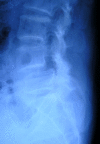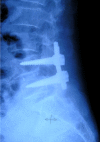Posterior lumbar interbody fusion versus posterolateral fusion in spondylolisthesis: a prospective controlled study in the Han nationality
- PMID: 18521599
- PMCID: PMC2898976
- DOI: 10.1007/s00264-008-0588-x
Posterior lumbar interbody fusion versus posterolateral fusion in spondylolisthesis: a prospective controlled study in the Han nationality
Abstract
In this prospective study, our aim was to compare the clinical outcome of posterior lumbar interbody fusion (PLIF) and posterolateral fusion (PLF) in spondylolisthesis. A total of 138 patients with spondylolisthesis were randomly assigned to two groups: those operated on with pedicle screw fixation and posterior lumbar interbody fusion by autografting (PLIF), and those operated on with pedicle screw fixation and posterolateral fusion by autografting (PLF). The patients were followed-up for four years. Clinical evaluation was carried out using the Oswestry disability index (ODI) and pain index (VAS). Radiography was performed preoperatively and postoperatively to assess the fusion. Both surgical procedures were effective, but the PLF group showed more complications related to hardware biomechanics. There was no significant statistical difference in clinical and functional outcome in the two groups. The PLIF group presented a better fusion rate than the PLF group.
Le but de cette étude prospective est de comparer les résultats et le devenir clinique de l'arthrodèse intercorporéale (PLIF) et des arthrodèses postérolatérales (PLF) dans le spondylolisthésis. 138 patients présentant un spondylolisthesis ont été randomisés en deux groupes: les opéré par fixation avec vis pédiculaires et fusion intercorporéale par voie postérieure et autogreffe (PLIF), et les a été opéré toujours par fixation pédiculaire mais avec greffes postéro-latérales (toujours par autogreffes) (PLF). Les patients ont été suivis pendant 4 ans. L'évaluation clinique a été réalisée à l'aide de l'index d'Oswestry (ODI) et la douleur à l'aide de l'échelle visuelle analogique. Les radiographies ont été réalisées en pré et post-opératoire de façon à évaluer la fusion. Ces deux procédés sont efficaces néanmoins, pour le groupe PLF, on déplore plus de complications relatives au matériel. Il n'y a pas de différences significatives sur le devenir clinique et fonctionnel dans les deux groupes, le groupe PLIF présentant un meilleur taux de fusion comparé au groupe PLF.
Figures
References
-
- Brantigan JW, Neidre A. Achievement of normal sagittal plane alignment using a wedged carbon fiber reinforced polymer fusion cage in treatment of spodylolisthesis. Spine. 2003;22:210–220. - PubMed
-
- Crawford S, Çagli S, Sontag VKH. Biomechanics of grade I degenerative lumbar spondylolisthesis: part 1. In vitro model. J Neurosurg. 2001;94(1):45–50. - PubMed
-
- Dantas FL, Prandini MN, Ferreira MA. Comparison between posterior lumbar fusion with pedicle screws and posterior lumbar interbody fusion with pedicle screws in adult spondylolisthesis. Arq Neuropsiquiatr. 2007;65:764–770. - PubMed
Publication types
MeSH terms
LinkOut - more resources
Full Text Sources
Other Literature Sources



